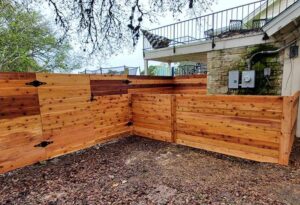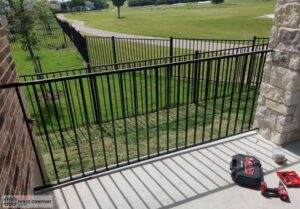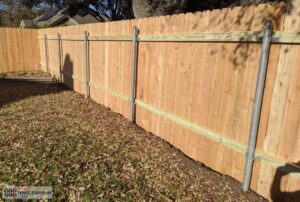Heat-Smart Fence Colors & Finishes for Austin Summers
TL;DR
Austin summers punish fences with UV, heat, and intermittent downpours. Choose finishes that reflect or dissipate heat, block UV, shed water, and stay manageable to re-coat. For wood, penetrating stains (light to medium tints) outperform paints in terms of breathability and maintenance. For metals, prefer matte powder coats that hide dust and reduce glare/hand-burn. For composites, pick lighter LRV hues with IR-reflective pigments. Design details matter: maintain a clean 2–3″ base gap, use crowned concrete collars, and align a 2–3 year care cycle. The color you pick, combined with thoughtful landscaping, changes surface temps, durability, and even how your yard feels at 5 p.m. in August.
Table of Contents
ToggleWhy Austin heat is different (and what it does to fences)

With Atlas Fence Company, you can choose fence colors and finishes that handle Austin’s UV, heat, and pop-up storms—running cooler to the touch, fading less, and staying easier to maintain season after season.
Central Texas throws a triple hit at exterior finishes:
- High UV index for long stretches → pigment fade and binder breakdown.
- Thermal cycling from late-day heat followed by overnight radiational cooling → checking, hairline cracks, and coating creep.
- Pop-up storms and west-facing sun → wet/dry swings that drive moisture into wood right when the surface is hottest.
Add reflective hardscape (light stone, pool decks) to your outdoor space and you’ve got radiant bounce that cooks lower fence boards. The right color and finish reduce surface temperature, slow UV damage, and make upkeep faster.
Color science in plain English: UV, IR, LRV, gloss, and glare
- UV vs. IR: UV (ultraviolet) fades color and breaks down binders; IR (infrared) is the heat you feel. Colors with IR-reflective pigments (often lighter, sometimes specialty blacks/bronzes) can run cooler than conventional formulas in the same hue family.
- LRV (Light Reflectance Value): Scale from 0 (black) to 100 (white). Higher LRV = more light reflection, generally cooler surfaces. In Austin yards, LRV 35–60 is a sweet spot for fences: bright enough to reduce heat, not so light that dust shows instantly.
- Gloss level: Gloss adds pop but increases glare and shows dust, chalking, and handprints. Satin or matte finishes stay visually cooler and hide grime.
- Hue bias: Warm dark browns absorb heat more than neutral or cool browns/charcoals with IR-reflective loads. Olive-charcoal and taupe-gray families often beat espresso tones in terms of touch temperature.
Wood fences: stain tones that run cooler and last longer
Penetrating stains are the workhorses in Austin because they move with the wood and are easy to refresh. Paint forms a film that can trap moisture—fine on a front door, risky on long, sun-blasted fence runs.
Pick a tone that fights heat (and still looks rich)
- Light to medium: weathered cedar, desert taupe, mesquite honey, cool umber—tones around LRV 30–50 feel lively yet don’t roast.
- Avoid super-dark espresso on west exposures with sprinklers; it looks sharp on day one but gets scorching and shows mineral spotting.
- Go slightly gray-biased if your house uses cool limestone or black windows; slightly warm-biased if the home has buff stone and tan trim.
Stain type matters
- Oil-modified or hybrid penetrating stains sink in, resist peeling, and re-coat without requiring sanding of the entire surface.
- Semi-transparent options show grain, hide dust, and help with UV; solid-color options run cooler in light, but behave more like paint—be honest about maintenance.
Boards, caps, and ground clearance
- Add a top cap to shade picket edges (less checking).
- Keep 2–3″ base clearance above soil/rock to reduce splashback and thermal wicking.
- Face the best grain outward on high-sun sides; vertical-grain pickets move less.
For deeper product selection tips and real-world color choosing, see our related guide: How to Choose the Best Fence Stain in Austin.
Metal fences: powder coats, touch temps, and finish texture

Ornamental steel and aluminum shine in modern homes Austin because they’re see-through (less sail effect) and low-mass (heat dissipates quickly). But color still matters.
- Color family: Matte black remains the crowd favorite because it visually disappears against live oaks. When touch temp is a concern (play yards, pool rails), consider graphite, bronze, or charcoal with IR-reflective loads—often cooler than jet black in late sun.
- Texture: A fine-textured matte finish hides dust and reduces skin-sizzle compared to slick gloss.
- Hardware & welds: Use the same powder family for touch-up kits; mixed sheens read patchy in low sun.
- Pool adjacency: Avoid spear-tops. Flat-top profiles reduce burn points and comply more easily with safety guidelines.
Composite & PVC: color stability, heat gain, and cleaning reality
Composites weather differently. Pigments are baked in, and many product lines now include IR-reflective technology.
- Choose mid-light tones (such as sand or driftwood gray) for deck-adjacent and west-facing exposures; darker charcoals can get too toasty against pavers.
- Surface embossing influences heat—deeper wood grain can trap dust but masks scuffs.
- Cleaning is simple (rinse + mild soap), but hard water spotting is a real issue. Keep sprinkler drift off fence faces.
Matching color to fence style, house palette, and microclimate
- Cedar privacy + limestone home: cool gray-brown stain, satin sheen, black hardware—crisp and heat-smart.
- Black window packages: a deep charcoal fence with IR pigments ties everything together, eliminating full black heat gain.
- Pool environments: light to medium tones with a low-glare finish keep the yard usable barefoot.
- Deep shade runs: you can go a touch darker—shades moderate heat and highlight rich color.
- South/west walls: stay lighter and matte; save saturated accents for planters and furniture.
Neighborhood & pool-area considerations (sightlines and safety)
- Sightlines: Along greenbelts, darker see-through systems recede; if privacy isn’t required, open styles feel cooler both visually and to the touch.
- Pool gates: Finishes should stay smooth and cool-ish at common grab points. Select latch/handle colors that won’t scorch; verify that self-closing hardware operates freely after the August heat.
- HOA cues: Many associations allow black, bronze, or dark charcoal metals; for wood, neutral stains receive the fastest approvals. Choose heat-smart within those lanes.
Build details that keep finishes cooler and drier.

Color is half the story—detailing makes it work.
- Crowned concrete collars at posts: shed water so stained wood doesn’t wick heat + moisture at ground line.
- Gravel beds below posts: drain pockets and cut decay risk under dark boards.
- Ventilated designs: cap + small gaps prevent steam-bath microclimates behind solid panels.
- Hardware choice: large, dark hinges become heat sinks; spec adjustable hardware with fine-texture coatings.
- Shade strategy: plant airy natives (muhly grasses, salvias) that diffuse afternoon sun without leaning on the fence.
For new or replacement work, coordinate finish choices, base gaps, and top caps during the fence installation process.
Maintenance rhythms that fit Austin’s calendar
- Every spring (March–April): Rinse dust/pollen, check base clearance, and spot-treat high-sun boards if needed.
- Early summer (May–June): Address sprinkler drift and hard-water spotting; touch up metal scuffs before peak UV exposure.
- Late summer (Aug): Inspect west runs for checking; schedule stain refresh if water no longer beads.
- Fall (Sep–Oct): Ideal window for full re-stain—cooler temps, lower foliage.
- Every 2–3 years: A full penetrating re-coat on wood keeps the color even and the boards protected.
Prefer to hand off the schedule? Book professional fence staining to refresh it during the optimal weather windows.
FAQs
Not if you choose the right sheen and texture for your privacy fence . Satin/matte finishes hide dust better than gloss, and neutral mid-light tones (such as taupe-gray or weathered cedar) effectively mask pollen and limestone dust.
They’re fine in morning sun or shaded runs and can look fantastic. On west exposures with sprinklers or pavers, they’ll run hotter and show water spotting sooner—plan for more frequent rinses and earlier refresh.
You can, but paint forms a film that’s less forgiving on long, sun-soaked runs. Penetrating stains breathe, move with boards, and are easier to refresh without stripping.
Rinse 2–3 times each summer, especially near pools or streets. Matte powder coats hide dust and lower touch temps; fix chips promptly to prevent under-film rust.
Every 2–3 years is a good rhythm; closer to 2 years on west-facing walls with lawn irrigation, and closer to 3 years in shaded or wind-sheltered sections.
Beat the Heat With Smarter Fence Finishes
Want a fence that looks cooler, feels cooler, and lasts longer through the Texas summer? We’ll guide you in choosing heat-smart colors and finishes, align them with your fence style and home palette, and schedule maintenance at the right time of year. Request a heat-smart color & finish estimate today.
